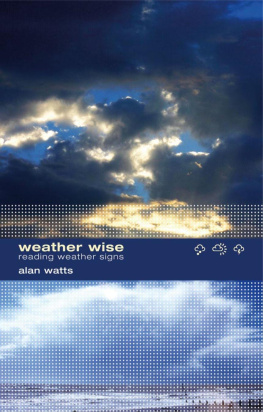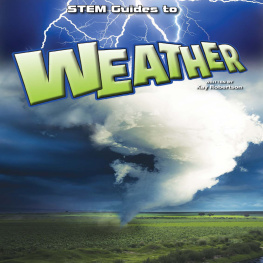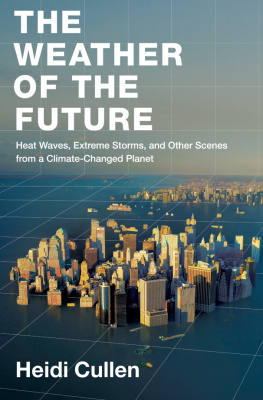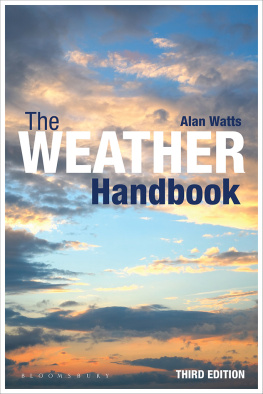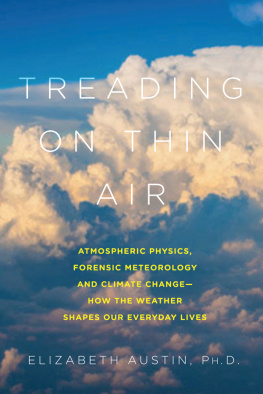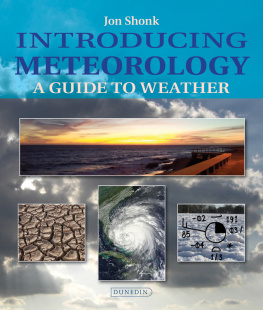Wilde called it the last refuge of the unimaginative but 120 years on, conversation about the weather has made a big comeback. Climate change, technical innovation, social media, stormchasersZion deals with them all. Read this book. Oh, and dont forget to pack your brolly.
Santo Cilauro
THE
WEATHER
OBSESSION
LAWRIE ZION

MELBOURNE UNIVERSITY PRESS
An imprint of Melbourne University Publishing Limited
Level 1, 715 Swanston Street, Carlton, Victoria 3053, Australia
mup-info@unimelb.edu.au
www.mup.com.au
First published 2017
Text Lawrie Zion, 2017
Design and typography Melbourne University Publishing Limited, 2014
This book is copyright. Apart from any use permitted under the Copyright Act 1968 and subsequent amendments, no part may be reproduced, stored in a retrieval system or transmitted by any means or process whatsoever without the prior written permission of the publishers.
Every attempt has been made to locate the copyright holders for material quoted in this book. Any person or organisation that may have been overlooked or misattributed may contact the publisher.
The extract on p. 8 is reproduced courtesy of the estate of Dorothea Mackellar. The extract on p. 9 and the first extract on p. 105 is reproduced courtesy of The Age. The extracts on pp. 42 and 121 are reproduced courtesy of Fairfax Media. The extracts on pp. 74, 1023, 105 (second extract), 111, 123, 127 and 1413 are reproduced courtesy of News Corp. The extract on p.122 is reproduced courtesy of Huffington Post Australia. The extracts on pp. 132 and 133 are reproduced courtesy of Heidi Cullen.
Text design and typesetting by Megan Ellis
Cover design by Design by Committee
Printed in Australia by McPhersons Printing Group
National Library of Australia Cataloguing-in-Publication entry
The weather obsession/Lawrie Zion.
9780522868418 (paperback)
9780522868425 (ebook)
Includes bibliographical references and index.
Weather forecastingAustralia.
Weather radar networksAustralia.
Weather forecastingData processing.
Social media.
CONTENTS
LIST OF ACRONYMNS
AAO | Antarctic Oscillation |
ACCESS | Australian Community Climate and Earth-System Simulator |
ACORN-SAT | Australian Climate Observations Reference-Network Surface Air Temperature |
AEMO | Australian Energy Market Operator |
AWS | Automatic Weather Station |
BoM | Bureau of Meteorology or Bureau |
CAWCR | Collaboration for Australian Weather and Climate Research |
CSIRO | Commonwealth Scientific and Industrial Research Organisation |
ECMWF | European Centre for Medium-Range Weather Forecasts |
ENSO | El NinoSouthern Oscillation |
FFDI | (McArthur) Forest Fire Danger Index |
IOD | Indian Ocean Dipole |
MJO | Madden-Julian Oscillation |
NOAA | National Oceanic and Atmospheric Administration |
PWS | Personal Weather Station |
SAM | Southern Annular Mode |
SOI | Southern Oscillation Index |
STEPS | Short Term Ensemble Prediction System |
WOW | Weather Observations Website |
PLUGGED INTO THE WEATHER
Full disclosure: I am a weather tragic. I have, since the age of five, been completely obsessed with the weather. The trigger, as I recall it, is also one of my earliest memories. I woke up one morning to see my suburban Melbourne street covered in a white blanket that I assumed to be snow. It turned out that there had been a hailstorm, and the ice soon melted. But at that moment I was captivated by natures special effects.
As soon as I could read I developed a newspaper habit that began with the weather pages, intrigued by not just the forecasts, but also the maps. To the surprise of my family I insisted, at the age of eight, that we get The Australian delivered because it was the only paper that featured detailed weather forecasts for all capital cities. I also watched the weather reports at the end of every TV news bulletin, listened to them on the radio and, if home from school, the broadcasts of the rainfall and river heights every day at twelve minutes to two. My idea of a fun day out was a trip with Mum to the Bureau of Meteorologys Melbourne office, where I would be given photocopies of monthly weather almanacs and climate stats by attentive, if bemused staff.
Its quite possible that I was the only nine-year-old who knew how unusual it was for Melbourne to have a 90-degree day (Fahrenheit; 32C) in the second half of April. Yet what might have seemed like a peculiar hobby turned out to be not so strange. Even author Mark Twain, a critic of the overblown weather clichs that appeared in so many nineteenth-century novels, conceded back in 1892 that weather is necessary to a narrative of human experience. Here in the twenty-first century, weather remains a part of our social lubrication, our identity, and it is central to how we live.
Weather is ideally suited to the electronic age, wrote Bernard Mergen, a Professor of American Studies, in his 2008 book Weather Matters. Its constantly in motion, frequently fast moving ubiquitous and visually beautiful.
And its in this digital age that our interest in the elements is being turbocharged by the growth of weather-related media, especially online. To misquote Prime Minister Turnbull, there has never been a more exciting time to be obsessed with the weather. But how is digital media reflecting and shaping the ways we connect to the weather, and our attempts to accommodate its extremes? Is it fulfilling some innate need, or engaging us in entirely new ways? These are the questions we will explore in this book.
The traces we leave on the internet often reveal insights about how and why we engage with the weather. Australians search online for weather more than we search for sex. According to Google, sex was a much more popular search term than weather in 2004. But by the beginning of 2017, weather outstripped sex by a ratio of four to onea trend replicated in several other western countries.
Bureau of Meteorology (Bureau/BoM) user surveys illustrate in more general (if less graphic) detail the extent to which online is now the go-to destination for weather. In 200506, just 39 per cent of us turned to the internet to find weather informationthat was less than television (90%), newspapers (65%) and radio (56%). A decade later, the proportion of Australians using the internet to find weather information had more than doubled to 80 per cent. Even so, broadcast remains important: 71 per cent were still getting forecasts on television and 66 per cent via radio. But, as a sign of the times, just 24 per cent of Australians turned to newspapers, the only one of these four platforms that cant tell you whats actually happening now.
These figures only really capture what we actively seek. Most of us also absorb weather information passively. Think of the temperature updates that beam at us every time we turn on our mobile devices, the embedded forecasts on news and social media sites, or the electronic tickers that pervade everything from cars to elevators.
Next page

